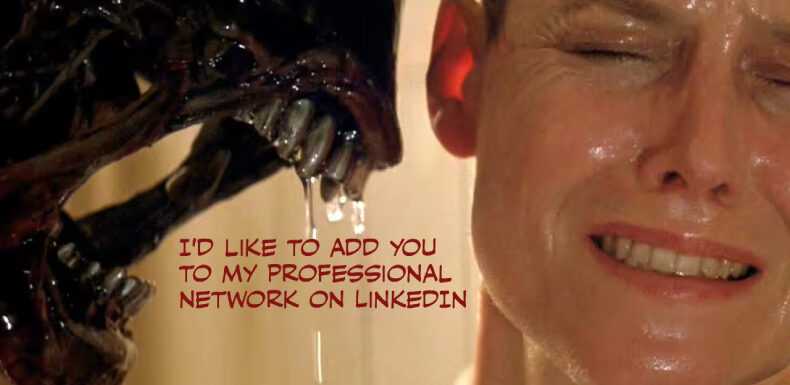
Have you ever searched the phrase “I’d like to add you to my professional network on LinkedIn” on Twitter? Or on Google Images?
Go ahead, try it. I’ll wait 🙂
You’ll find endless memes mocking that phrase.
Like this:
Or this.
Or this one (play it and see), which is painfully accurate.
Why the mockery? Because LinkedIn connection requests have become shorthand for “consent to cold-call/spam.” Accepting one often leads to an immediate follow-up DM where the sender wants something—usually to sell, pitch, or push.
To be fair, not everyone abuses connection requests. But the jokes reflect a widespread truth: most people are far too liberal with whom they accept on LinkedIn, in contrast to Facebook friend requests.
Think about the difference:
Accepting a friend request on Facebook feels like letting someone into your home. It’s private, so you’re cautious.
Accepting a connection request on LinkedIn feels like letting someone into your office. Offices are more public, and you’re open to opportunities—so you let strangers in.
But here’s the thing: you don’t need to.
A short history lesson
LinkedIn launched in 2003, before Facebook, Instagram, and Twitter. For nearly a decade, the only way to engage was to connect. This was modeled on exchanging business cards—mutual, formal, and two-way.
That changed in 2012, when LinkedIn rolled out its Influencers program. A handful of offline celebrities like Richard Branson could suddenly “broadcast” without needing connections. To make this work, LinkedIn introduced a new option: Follow.
By 2018, LinkedIn expanded “Follow” to 25,000 users. Today, it’s available to everyone—but most people still don’t realize they can change their profile’s default action from Connect to Follow (here’s how).
And they should.
Connections vs. Follow
Here’s the difference in plain English:
Connections: Two-way street. You see each other’s posts. You can DM each other freely.
Follow: One-way street. You see their posts. They don’t see yours.
Also: the moment you send someone a connection request, you automatically follow them—even if they don’t accept. You’ll see their posts, but they may never see yours.
So, in reality, a connection request is just a dressed-up way of asking: “Please follow me back and let me DM you.”
Why Follow > Connect for personal branding
If you’re serious about personal branding, “Follow” on LinkedIn is infinitely more useful.
Personal branding is about building perception through content. That means consistently sharing insights, opinions, and experiences that shape how people in your industry see you.
But here’s the catch: you can’t build a brand only among people who already know you. You need to reach strangers. On Twitter or Instagram, this is baked in—the follow model enables visibility far beyond your immediate circle. LinkedIn only caught up in 2018.
So, instead of sending connection requests to strangers:
Follow them. See if they post consistently and if their views are valuable.
How?
a. Go to their profile. Go to ‘Activity’ and ‘See all posts’. Select ‘Posts’ and check the frequency and quality of posts.
b. Then select ‘Comments’ and check the quality of comments (that they have left on others’ posts).
c. Why do this? To check the frequency and quality of content. To see if they are consistent with their point of view, views, and perspectives (that you found useful through one post). Or, if it is sporadic (once every 3-6 months type). If there is consistency (which would be useful to you) then…
d. Follow that person on LinkedIn
This way, their content enriches your feed, and they don’t feel ambushed.
If you genuinely need something—like a job lead or a potential collaboration—send a connection request with a note explaining why. Be upfront.
How I handle connection requests
I get this asked in almost every personal branding workshop I conduct. It usually goes like this: “Karthik, I have about 1,500 connection requests pending on LinkedIn! Is there an easy to know which ones to connect and which ones to ignore? Won’t those I have ignored feel bad?”.
First things first, no – those you ignore will not get an alert from LinkedIn about it. They can only make an informed guess by constantly looking at your profile being called ‘2nd’ (or second degree) that you haven’t taken any action on their request.
And no, there’s no easy method to do this. Every method is personal and useful to that person. Here’s what I do.
I get 50+ requests a day. I reject most. The rare few I accept pass this test:
1. Their posts, not just bio, show they have useful (to me) perspectives.
2. I can see them (quick mental check) being helpful to someone in my network.
3. I can see myself learning something useful from them.
If all three click, I connect. Otherwise, I decline. Incidentally, this is not very different from exchanging business cards in an event. Unfortunately, when someone hands over their card to you in an offline event, out of social obligations and civil politeness, you may be forced to give your card in return. Thankfully, no such obligations on LinkedIn.
The irony
By clinging to “connections,” people are stuck in LinkedIn’s old model. They think it’s about building a network (here is the difference between professional networking and personal branding, while we are on that subject). But if you think long-term, LinkedIn is really about building professional visibility.
And that’s done best by:
1. Sharing your own perspectives consistently.
2. Following others who do the same.
3. Letting the algorithm extend your reach to second- and third-degree professionals.
So, stop connecting with strangers just for the sake of it. Switch your profile’s default button to Follow. Build your brand by what you say, not how many random people you’ve “added to your professional network.”
PS: If you really know the other person, have worked or engaged with them, please go ahead and connect with them on LinkedIn. There are definite benefits to connecting on LinkedIn with people you know.
